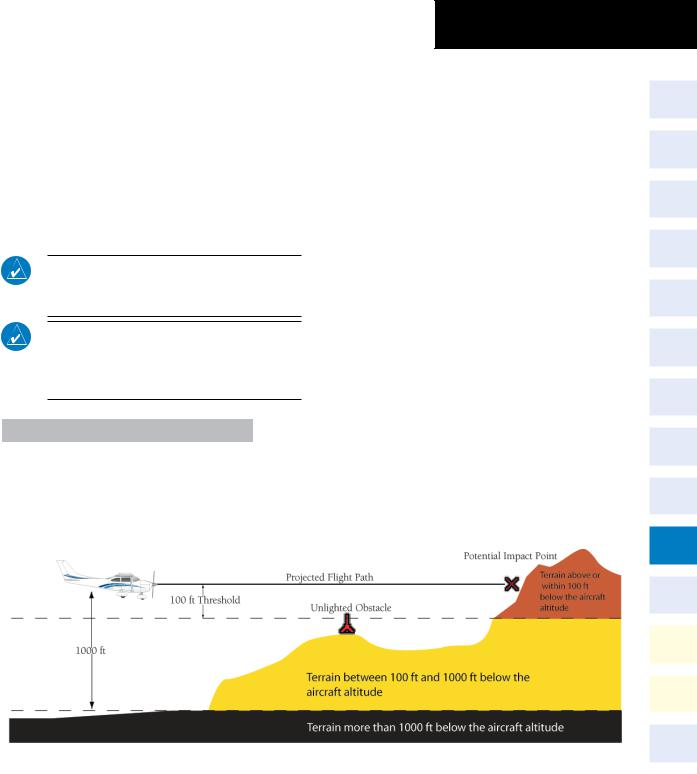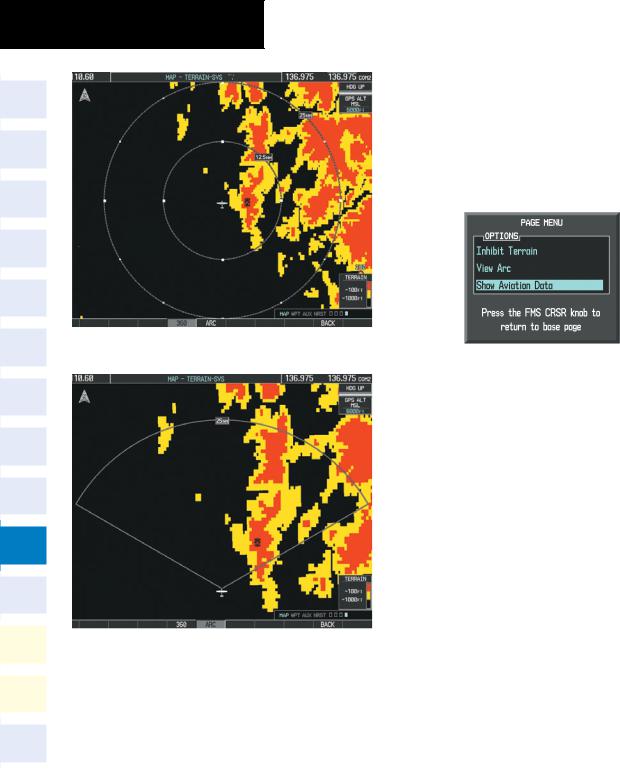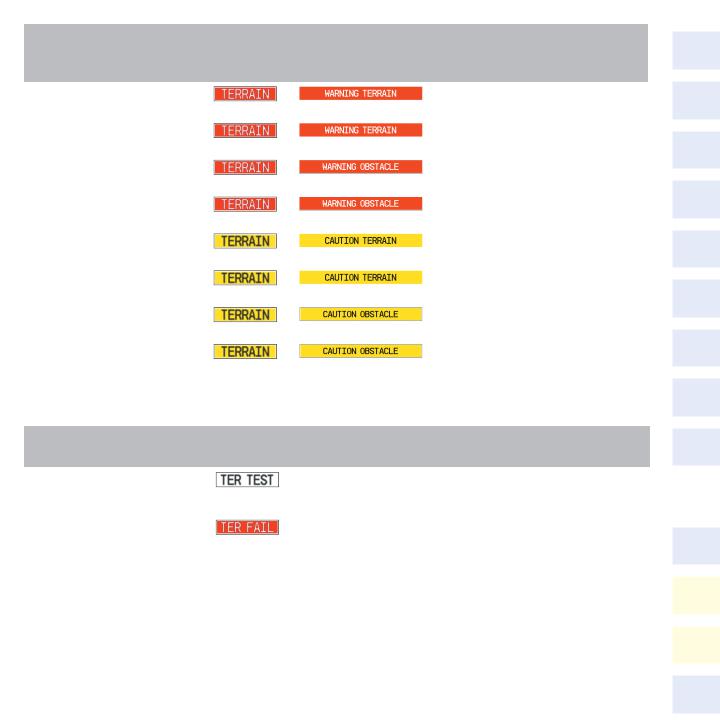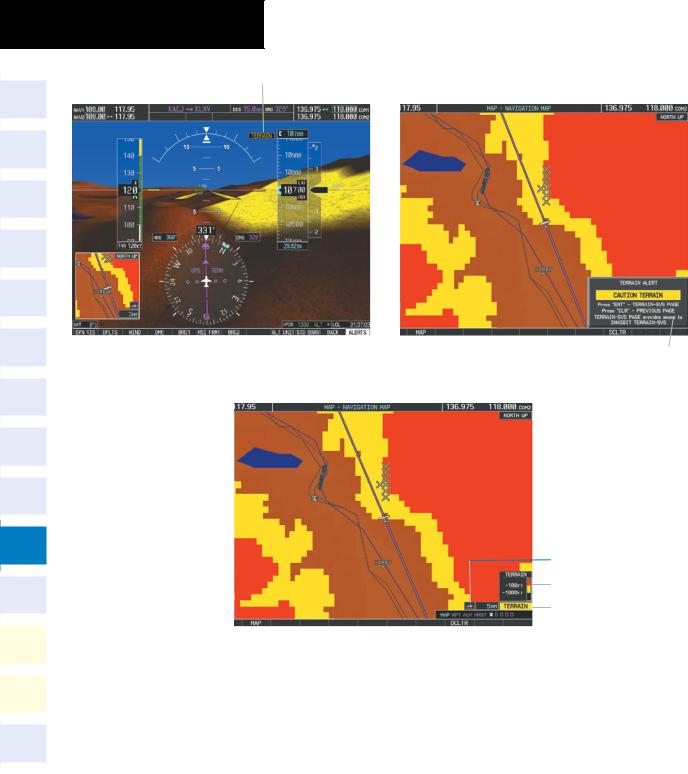
- •Section 1: System Overview
- •1.1 PFD/MFD Controls
- •1.2 PFD Softkeys
- •1.3 MFD Softkeys
- •1.4 MFD Page Groups
- •1.5 Vertical Navigation
- •1.6 Backlighting
- •1.7 Database Updates
- •Jeppesen Aviation Database
- •Garmin Databases
- •Section 2: Flight Instruments
- •2.1 Airspeed Indicator
- •Speed Indication
- •Speed Ranges
- •Airspeed Trend Vector
- •Vspeed References
- •2.2 Attitude Indicator
- •2.3 Altimeter
- •Selected Altitude Bug
- •Altitude Trend Vector
- •Barometric Setting Box
- •Altitude Alerting
- •Metric Display
- •Low Altitude Annunciation
- •2.5 Marker Beacon Annunciations
- •2.6 Vertical Speed Indicator
- •2.7 Barometric Altitude Minimums
- •2.8 Horizontal Situation Indicator (HSI)
- •Course Pointer
- •Course Deviation Indicator (CDI)
- •Bearing Pointers and Information Windows
- •DME (optional)
- •Navigation Source
- •2.9 Wind Data
- •2.10 Generic Timer
- •3.1 Engine Display
- •3.2 Lean Display
- •Normally-aspirated Aircraft
- •Turbocharged Aircraft
- •3.3 System Display
- •4.1 Radio Status Indications
- •4.2 Volume
- •4.3 Automatic Squelch
- •4.4 Quickly Activating 121.500 MHz
- •4.5 Optional NAV Radios
- •DME Radio (optional)
- •ADF Radio (optional)
- •Auto-tuning on the PFD
- •Auto-tuning on the MFD
- •4.7 Transponder
- •Mode Selection
- •Reply Status
- •Code Selection
- •Flight ID Reporting
- •Section 5: Audio Panel
- •5.1 COM Radio Selection
- •5.2 Cabin Speaker
- •5.3 Passenger Address (PA) System (T)182T and (T)206H Only
- •5.4 Marker Beacon Receiver
- •Marker Beacon Signal Sensitivity
- •5.5 Nav Radio Audio Selection
- •5.6 Intercom System (ICS) Isolation
- •5.7 Intercom Squelch Control
- •5.8 Digital Clearance Recorder and Player
- •6.1 AFCS Controls
- •6.2 Flight Director Operation
- •Activating the Flight Director
- •Command Bars
- •AFCS Status Box
- •6.3 Flight Director Modes
- •Pitch Modes
- •Roll Modes
- •6.4 Autopilot Operation
- •Flight Control
- •Engaging the Autopilot
- •Control Wheel Steering
- •Disengaging the Autopilot
- •6.5 Example Procedures
- •Departure
- •Intercepting a VOR Radial
- •Flying a Flight Plan/GPS Course
- •Descent
- •Approach
- •Go Around/Missed Approach
- •6.6 AFCS Annunciations and Alerts
- •AFCS Status Alerts
- •Overspeed Protection
- •Section 7: Navigation
- •7.1 Navigation Map Page
- •Direct-to Navigation from the MFD
- •Direct-to Navigation from the PFD
- •7.3 Navigating an Example Flight Plan
- •7.4 Airport Information
- •7.5 Intersection Information
- •7.6 NDB Information
- •7.7 VOR Information
- •7.9 Nearest Airports
- •Nearest Airport Information on the MFD
- •Nearest Airports Information on the PFD
- •7.10 Nearest Intersections
- •7.11 Nearest NDB
- •7.12 Nearest VOR
- •7.13 Nearest User Waypoint
- •7.14 Nearest Frequencies
- •7.15 Nearest Airspaces
- •Section 8: Flight Planning
- •8.1 User Defined Waypoints
- •Select the User WPT Information Page
- •Create User Waypoints from the Navigation Map Page
- •8.2 Viewing the Active Flight Plan
- •8.3 Activate a Stored Flight Plan
- •8.4 Activate a Flight Plan Leg
- •8.5 Stop Navigating a Flight Plan
- •8.6 Invert Active Flight Plan
- •8.7 Create a New Flight Plan
- •Create a New Flight Plan Using the MFD
- •Create a New Flight Plan Using the PFD
- •8.8 Enter an Airway in a Flight Plan
- •8.9 Load a Departure
- •8.10 Load an Arrival
- •8.11 Load an Approach
- •8.12 Remove a Departure, Arrival, Approach, or Airway from a Flight Plan
- •8.13 Store a Flight Plan
- •8.14 Edit a Stored Flight Plan
- •8.15 Delete a Waypoint from the Flight Plan
- •8.16 Invert and Activate a Stored Flight Plan
- •8.17 Copy a Flight Plan
- •8.18 Delete a Flight Plan
- •8.19 Graphical Flight Plan Creation
- •8.20 Trip Planning
- •Section 9: Procedures
- •9.1 Arrivals and Departures
- •Load and Activate a Departure Procedure
- •Load and Activate An Arrival Procedure
- •9.2 Approaches
- •Load and/or Activate an Approach Procedure
- •Activate An Approach in the Active Flight Plan
- •Section 10: Hazard Avoidance
- •10.1 Customizing the Hazard Displays on the Navigation Map
- •10.2 STORMSCOPE® (Optional)
- •Displaying Stormscope Lightning Data on the Navigation Map Page
- •Stormscope Page
- •10.3 XM Weather (Service Optional)
- •Displaying METAR and TAF information on the Airport Information Page
- •Displaying Weather on the Weather Data Link Page
- •Weather Products & Symbols
- •Weather Product Age
- •10.4 Traffic Systems
- •Traffic Information Service (TIS)
- •Traffic Advisory System (TAS) (Optional)
- •ADS-B Traffic (Optional)
- •10.5 Terrain and Obstacle Proximity
- •Displaying Terrain and Obstacles on the Navigation Map
- •10.6 TERRAIN-SVS Display (Optional)
- •Displaying Terrain on the TERRAIN-SVS Page
- •Enable/Disable Aviation Data
- •TERRAIN-SVS Alerts
- •Terrain Inhibit
- •Forward Looking Terrain Avoidance (FLTA)
- •10.7 Terrain Awareness & Warning System (TAWS) Display (Optional)
- •Displaying Terrain on the TAWS Page
- •Enable/Disable Aviation Data
- •TAWS Inhibit
- •Manual System Test
- •Forward Looking Terrain Avoidance (FLTA)
- •Premature Descent Alert (PDA)
- •Excessive Descent Rate Alert (EDR)
- •“Five-Hundred” Aural Alert
- •Displaying Terrain and Obstacles on the Navigation Map
- •Pop-up Alerts
- •TAWS Alerts Summary
- •Alert Annunciations
- •11.1 Synthetic Vision System (SVS) (Optional)
- •SVS Operation
- •SVS Features
- •Field of View
- •11.2 SafeTaxi
- •11.3 ChartView
- •Chart Options
- •Day/Night View
- •11.4 FliteCharts
- •Chart Options
- •Day/Night View
- •11.5 XM Radio Entertainment
- •Using XM Radio
- •Automatic Audio Muting
- •11.6 Scheduler
- •11.7 Electronic Checklists
- •12.1 Reversionary Mode
- •12.2 Abnormal COM Operation
- •12.3 Unusual Attitudes
- •12.4 Stormscope Operation with loss of Heading Input
- •12.5 Hazard Displays with Loss of GPS Position
- •12.6 Dead Reckoning
- •13.1 Alert Level Definitions
- •13.2 NAV III Aircraft Alerts
- •CAUTION Alerts (T182, T206, and 206 with Prop De-Ice Only)
- •Safe Operating Annunciation (T182, T206, and 206 with Prop De-Ice Only)
- •13.3 CO Guardian Messages
- •13.4 AFCS Alerts
- •System Status Annunciation
- •13.5 TAWS Alerts
- •13.6 Other G1000 Aural Alerts
- •13.7 G1000 System Annunciations
- •13.8 G1000 System Message Advisories
- •MFD & PFD Message Advisories
- •Database Message Advisories
- •GMA 1347 Message Advisories
- •GIA 63 Message Advisories
- •GIA 63W Message Advisories
- •GEA 71 Message Advisories
- •GTX 33 Message Advisories
- •GRS 77 Message Advisories
- •GMU 44 Message Advisories
- •GDL 69/69A Message Advisories
- •GDC 74A Message Advisories
- •Miscellaneous Message Advisories
- •Index
- •1.1 PFD/MFD Controls
- •Speed Ranges
- •3.1 Engine Display
- •4.7 Transponder
- •Command Bars
- •Flight Control
- •Control Wheel Steering
- •Select the MAP Page Group
- •Select the Airport Information Page
- •Select the Intersection Information Page
- •Select the NDB Information Page
- •Select the VOR Information Page
- •Select the Nearest Intersections Page
- •Select the Nearest NDB Page
- •Select the Nearest VOR Page
- •Select the Nearest User Waypoint Page
- •Select the Nearest Frequencies Page
- •Select the Nearest Airspaces Page
- •11.4 FliteCharts
- •System Status Annunciation

Displaying Terrain and Obstacles on the Navigation Map
1)With the Navigation Map displayed, press the MAP Softkey.
2)Press the TERRAIN Softkey. Terrain and obstacle proximity is now displayed on the map.
10.6 TERRAIN-SVS Display (Optional)
NOTE: Terrain data is not displayed when the aircraft latitude is greater than 75 degrees north or 60 degrees south.
NOTE: TERRAIN-SVS operation is only available when the Synthetic Vision System is installed. TAWS will take precedence over TERRAIN-SVS when installed.
Color |
Terrain/Obstacle Location |
|
Red |
Terrain/Obstacle above or within 100’ |
|
below current aircraft altitude. |
||
|
||
Yellow |
Terrain/Obstacle between 100’ and |
|
1000’ below current aircraft altitude. |
||
|
||
Black |
Terrain/Obstacle is more than 1000’ |
|
below aircraft altitude. |
||
|
SECTION 10 – HAZARD
AVOIDANCE
Displaying Terrain on the TERRAIN-SVS Page
1)Turn the large FMS Knob to select the Map Page Group.
2)Turn the small FMS Knob to select the TERRAIN-SVS Page.
3)If desired, press the VIEW Softkey to access the ARC and 360 Softkeys. When the ARC Softkey is pressed, a radar-like 120° view is displayed. Press the 360 Softkey to return to the 360° default display.
4)Rotate the Joystick clockwise to display a larger area or rotate counter-clockwise to display a smaller area.
190-00384-09 Rev. A |
Garmin G1000 Cockpit Reference Guide for the Cessna Nav III |
10-11 |

SECTION 10 – HAZARD
AVOIDANCE
Enable/Disable Aviation Data
1) While the TERRAIN-SVS Page is displayed, press the MENU Key.
2) Turn the small FMS Knob to select “Show (or Hide) Aviation Data”.
3) Press the ENT Key.
Figure 10-18 Terrain-SVS Page (360˚ View)
Figure 10-20 Terrain-SVS Page Menu
TERRAIN-SVS Alerts
Alertsareissuedwhenflightconditionsmeetparameters that are set within TERRAIN-SVS software algorithms. TERRAIN-SVS alerts typically employ a CAUTION or a WARNING alert severity level, or both. When an alert is issued, visual annunciations are displayed and aural alerts are simultaneously issued. Table 10-1 shows TERRAINSVS alert types with corresponding annunciations and aural messages.
When an alert is issued, annunciations appear on the PFD and MFD. The TERRAIN-SVS Alert Annunciation is shown to the upper left of the Altimeter on the PFD and below the Terrain Legend on the MFD. If the TERRAIN-
Figure 10-19 Terrain-SVS Page (ARC View) SVS Page is not displayed at the time, a pop-up alert appears on the MFD. To acknowledge the pop-up alert:
• Press the CLR Key (returns to the currently viewed page), or
• Press the ENT Key (accesses the TERRAIN-SVS
Page)
10-12 |
Garmin G1000 Cockpit Reference Guide for the Cessna Nav III |
190-00384-09 Rev. A |

|
|
|
|
|
SECTION 10 – HAZARD |
||
|
|
|
|
|
AVOIDANCE |
||
|
|
|
|
|
|
|
|
|
|
|
|
|
|
|
|
|
PFD/MFD |
MFD |
|
|
|
|
|
Alert Type |
Alert |
|
|
Aural Message |
|
|
|
Pop-Up Alert |
|
|
|
||||
|
Annunciation |
|
|
|
|
|
|
|
|
|
|
|
|
|
|
|
|
|
|
|
|
|
|
Reduced Required Terrain Clearance |
|
|
|
|
“Warning; Terrain, Terrain” |
|
|
Warning (RTC) |
|
|
|
|
|
|
|
|
|
|
|
|
|
|
|
Imminent Terrain Impact Warning (ITI) |
|
|
|
|
“Warning; Terrain, Terrain” |
|
|
|
|
|
|
|
|
|
|
Reduced Required Obstacle Clearance |
|
|
|
|
“Warning; Obstacle, Obstacle” |
|
|
Warning (ROC) |
|
|
|
|
|
|
|
|
|
|
|
|
|
|
|
Imminent Obstacle Impact Warning (IOI) |
|
|
|
|
“Warning; Obstacle, Obstacle” |
|
|
|
|
|
|
|
|
|
|
Reduced Required Terrain Clearance |
|
|
|
|
“Caution; Terrain, Terrain” |
|
|
Caution (RTC) |
|
|
|
|
|
|
|
|
|
|
|
|
|
|
|
Imminent Terrain Impact Caution (ITI) |
|
|
|
|
“Caution; Terrain, Terrain” |
|
|
|
|
|
|
|
|
|
|
Reduced Required Obstacle Clearance |
|
|
|
|
“Caution; Obstacle, Obstacle” |
|
|
Caution (ROC) |
|
|
|
|
|
|
|
|
|
|
|
|
|
|
|
Imminent Obstacle Impact Caution (IOI) |
|
|
|
|
“Caution; Obstacle, Obstacle” |
|
|
|
|
|
|
|
|||
|
Table 10-1 TERRAIN-SVS Alerts Summary |
||||||
|
|
|
|
|
|
|
|
Alert Type |
PFD/MFD Alert |
|
|
Aural Message |
|
|
|
Annunciation |
|
|
|
||||
|
|
|
|
|
|
|
|
System Test in Progress |
|
|
|
|
None |
|
|
|
|
|
|
|
|||
|
|
|
|
|
|
||
System Test Pass |
None |
|
“Terrain System Test OK” |
|
|
||
Terrain System Test Fail |
|
|
“Terrain System Failure” |
|
|
||
|
|
|
|||||
|
|
|
|
||||
|
Table 10-2 TERRAIN-SVS System Test Status Annunciations |
||||||
190-00384-09 Rev. A |
Garmin G1000 Cockpit Reference Guide for the Cessna Nav III |
10-13 |

SECTION 10 – HAZARD
AVOIDANCE
Alert Annunciation
Figure 10-21 TERRAIN-SVS Alert Annunciations
Figure 10-22 Navigation Map Page
(After TERRAIN-SVS Pop-up Alert Acknowledgment)
Pop-up
Alert
Terrain Display Enabled
Terrain Legend
Alert Annunciation
10-14 |
Garmin G1000 Cockpit Reference Guide for the Cessna Nav III |
190-00384-09 Rev. A |
